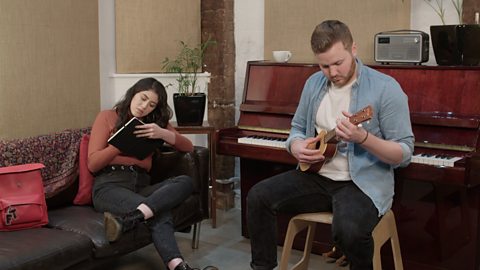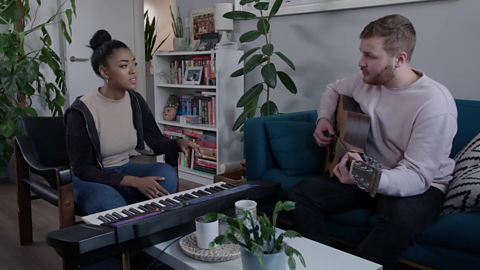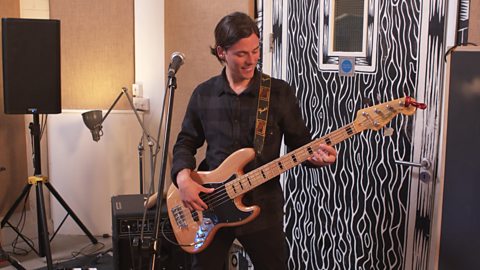- Explore how film music is composed and hear examples from The Avengers, James Bond and Requiem for a Dream.
- Understand leitmotifs, chromatics and other key terms.
- Make your own film composition.
Watch to find out how Nainita Desai composes music for films and TV.
MUSIC
Marcelo: How did you get started composing for film and TV?
Nainita: I sort of taught myself how to write music for TV. The way that I approached it really was by studying and watching other TV programmes. So I’d watch a TV programme and enjoy it, but then I’d watch it again and again, trying to analyse how did it make me feel? Sort of happy, sad, full of fear? I’d have the film up on my computer screen and I would try different sounds, try different melodies, add other instruments and other elements to it.
Marcelo: What can a composer add to a film with their music?
Nainita: Music can really work as an incredible tool to bring out the motions and really enhance the storytelling. Another really interesting use of music is to tell you when a film is set. So if it’s a period drama like Pride and Prejudice or Jane Austen, you might hear some sort of classical music. And also with the location, if you have a film that’s set in a foreign country like Australia or Japan, you might hear ethnic instruments.
Marcelo: How do you get started on a project?
Nainita: This is a wildlife film that I’ve been working on. This is a little scene about two baby chicks and I wanted to write a melody, a theme for them that was soft and warm.
PIANO PLAYS
Nainita: And because they’re very young, it’s quite delicate and fragile, and gentle. But I thought it would be really lovely to have the flute playing it, and then I’ll have other instruments coming in as well. So I’ll play you a more developed form.
FLUTE PLAYS
Nainita: Later on in the sequence, these little baby chicks are quite vulnerable because there’s a big bird of prey that’s out to hunt them. So, the music had to change in pace and action, and become full of tension. So I came up with a very simple pulse like this.
KEYBOARD PLAYS
Nainita: And when you add lots and lots of other instruments like this whole orchestral string section, it becomes very effective, like this.
DRAMATIC MUSIC PLAYS
Nainita: So there you go.
Marcelo: Wow! Do you have any tips for someone who is interested in getting started in film and TV composition?
Nainita: One of the most important things is to actually watch feature films, dramas, TV programmes with the music in mind. Listen to the music. How is it making you feel? The other thing that’s really important is to get to grips with music technology; software and computers, and synthesizers, and that’s a really important part of being a media composer. If you want to learn, it’s so easy these days. There are lots of free online tutorials and videos, so there’s no excuse.
Marcelo: Thank you so much seeing me, Nainita, here at your studio. It’s been absolutely great!
The first film containing sound (both music and spoken dialogue) was The Jazz Singer, released in 1927. Since then, music has been an extremely important part of cinema.
Film composers use music to create atmosphere, sync with on-screen action, and create iconic themes associated with characters in movies.
A film composer will sit down with a director and discuss ideas for a film's soundtrack. The composer will then work on ideas for themes and other music.
Once the film has been shot, the composer will write a number of 'cues' (sections of music to be used in the film). The music will then be recorded and added to the film.

Key parts of film music
Leitmotif is a German word meaning leading motif. In music it refers to a musical phrase that represents a character, place or idea.
Different musical ideas lend themselves to different types of character. Characters such as Jaws (the shark), or Luke Skywalker from Star Wars have instantly recognisable leitmotifs.

Listen to this leitmotif for a character using only C and G (two notes a 'fifth' apart).
The hero: the fifth
The interval of a fifth is two notes that are five notes apart. It is used in many leitmotifs for heroic characters.
Listen to this leitmotif. A film villain might sound like this.
The villain: chromatic notes
Leitmotifs for villains often use chromatic notes. These are one semitone apart, very close together. Villain themes can also use awkward leaps over long distances between notes.
How the musical material is arranged - the choice of which instruments play the melody, chords, bass line or other parts of the music - will affect how the leitmotif is heard by the listener. For example:
- The hero's leitmotif played on brass instruments, accompanied by fanfare-like rhythms, will suggest our hero is triumphant.
- The same leitmotif played by lower instruments, accompanied by eerie sounding chords, will suggest our hero is lost or sneaking around.
Listen to famous pieces of film music
Listen to a full orchestra play Portals by Alan Silvestri. This famous theme from The Avengers films is triumphant and heroic, with the leitmotif celebrating the many heroes of the films all coming together.
Listen to the James Bond theme by Monty Norman. This iconic British film theme contains a repeated guitar riff, along with a swing style accompaniment.
Listen to Lux Aeterna by Clint Mansell. This famous theme was originally written for the movie Requiem for a Dream. It has since been used in many different films and contexts, including a Lord of the Rings trailer and even as walk on music for football matches!
Create a leitmotif for yourself
Are you a hero or a villain? Try to create a short musical idea that would work as a leitmotif if you were a character in a film.
What is your favourite film? Listen to the music used when your favourite character is on screen, how does it change throughout the film?
If you want to be the hero, use two notes a fifth apart (like C and G, G and D, or F and C). Base your leitmotif around these two notes.
If you’d rather be the villain, try to use notes very close together (creating chromatic melodies), or leap different distances between notes (some awkward leaps include C-F#, C-G# or C-B).
Keywords
| Keyword | Definition |
|---|---|
| cue | A section of music used in a film. |
| leitmotif | A melody used to represent a character or an idea, usually found in film music. |
| a fifth | Two notes, five notes apart (for example, C-G, G-D, F-C). |
| chromatic notes | Notes that are very close together, just a semitone apart. |
| leaps | A distance between two different pitches. |
| arranging | Taking musical ideas and deciding which instruments will play them, as well as what music will accompany those ideas. |
Play Bitesize secondary games. game
Have fun playing science, maths, history, geography and language games.

More on Composing music
Find out more by working through a topic
- count1 of 8

- count2 of 8

- count3 of 8

- count4 of 8
